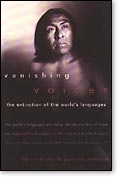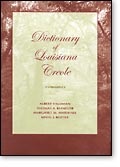Preston Jones
Endangered Species
3,000 of the world's 6,000 languages are scheduled for extinction by the year 2100.
Language Death

Vanishing Voices
Language Death, by David Crystal, Cambridge University Press, 198 pp.; $19.95
Vanishing Voices: The Extinction of the World's Languages, by Daniel Nettle and Suzanne Romaine, Oxford University Press, 241 pp.; $27.50
Dictionary of Louisiana Creole, edited by Albert Valdman, Thomas Klingler, Margaret M. Marshall, and Kevin J. Rottet, Indiana University Press, 656 pp.; $89.95

Dictionary of Louisiana Creole
Save the trees, save the ozone, save the lonely dogs now wasting in the backyards of middle-class America. Causes pile up and pit themselves against shrinking time. And then, sometimes, time just runs out. The Ubykh language was heard in the northwestern Caucasus until its last speaker, Tefvik Esenc, died in 1992. The last native speaker of Manx, the Celtic speech of the Isle of Man, was Ned Maddrell, who died in 1974. And while Manx enthusiasts have brought the language back into their island's cultural life, it's unlikely that fluency on the order of Maddrell's will ever again be captured. Ditto for Cornish. Ditto for the Gaelic dialect spoken in East Sutherland, Scotland, whose death has been so competently documented by linguist Nancy Dorian. Ditto as well for the some 51 languages in the world that, as of 1999, had a single speaker. And also, unless something is done to alter the present reality, for the 3,000 of the world's 6,000 languages that are scheduled for extinction by the year 2100.
Four percent of the world's population—mostly indigenous peoples inhabiting out-of-the-way places—speak 96 percent of the world's languages. Five hundred of the globe's tongues now have less than 100 speakers. A Coke and fries will never be ordered in Eyak, Wappo, or Catawba Sioux.
David Crystal, Daniel Nettle, and Suzanne Romaine are understandably upset, and they want something to be done to stop linguistic decline. "To fight to preserve the smaller cultures and languages may turn out to be the struggle to preserve the most precious things that make us human before we end up in the land fill of history," says Ron Crow in an editorial published in Iatiku. Crow is quoted by Crystal in Language Death, a tract in tended to spur us to action on behalf of the hundreds of endangered languages. Critics could perhaps point out that Crow, with Crystal's approval, manages to sneak two clichés into a single sentence ("the most precious things that make us human" and "the land fill of history"); and indeed, while Language Death is informative and engaging, it is also a veritable fount of slogans and trite observations: "a language is really alive only as long as there is someone to speak it to." Nettle and Romaine's goal is the same as Crystal's: 90 percent of Australia's Aboriginal languages are near extinction, they write, and something should be done about that. But because their text is more theoretical and descriptive and less activist in tone than Crystal's, it is the superior read.
One of Crystal's six "postulates for a theory of language revitalization" is that "An endangered language will progress if its speakers can write their language down," but neither he nor Nettle and Romaine say much about Wycliffe Bible Translators and SIL, whose work has helped preserve many endangered languages and drawn attention both to the riches of "minority languages" and to the threat of extinction.[1] In a grudging tribute, Nettle and Romaine concede that "the Summer Institute of Linguistics (SIL), a fundamentalist mission group based in the United States and the largest Protestant missionary society sent abroad, probably has a better idea of the scope of the problem of language endangerment than most academic linguists. Although SIL's primary interest is not language maintenance, but the provision of Bible translations for the peoples of the world, their workers have more firsthand experience in documenting languages on a large scale."
The causes of language death are numerous, though not usually difficult to figure: TV, urbanization, government oppression, stupidity, neglect, illiteracy, upward mobility, and the desire to leave less prestigious languages behind. Conditions unique to the modern world have rapidly accelerated the pace of language extinction.
As for what's to be done to preserve dying tongues, the authors' advice is fairly straightforward in theory if more cumbersome in practice: "identify and stabilize languages under threat so that they can be transmitted to the next generation in as many functions as possible" (Nettle and Romaine); "An endangered language will progress if its speakers increase their prestige within the dominant community" (Crystal); "Minority groups who have retained control over their schooling, such as the Old Order Amish in Pennsylvania, have … shown greater language maintenance than those who have not" (Nettle and Romaine); "An endangered language will progress if its speakers can make use of electronic technology" (Crystal); and so on.
Obviously, linguists themselves can't do much more than document endangered languages before they vanish. Kevin Rottet, a linguist at the University of Wisconsin at Whitewater, asserts that "only native speakers can [save their languages], mainly by speaking their language to their small children." Crystal, Nettle, Romaine, and Rottet agree that linguists would do the world a favor if many of them shifted their attention from large, majority languages to the endangered kind. And Rottet is playing his part: a coeditor of the Dictionary of Louisiana Creole, he is now working with other linguists on a dictionary of Cajun, and he aspires to teach Welsh to North Americans with an interest in that ancient, endangered, and famously difficult tongue.
Unlike Welsh—which, almost uniquely among languages that were in sure decline 30 years ago, is making something of a comeback—the future of Cajun French and Creole in Louisiana isn't bright. There are very few speakers of either language under 50 years of age, Rottet told me in an interview, "and not enough concentrated in most areas to form a speech community in any useful sense once the older speakers have passed on."
As is in true in many places where old tongues are languishing, there is a movement afoot (spearheaded by the Council on the Development of French in Louisiana) to preserve French in Louisiana, though it's impossible to predict the long-term effect of this effort. Most Cajuns and Creoles do not read French, so even if the movement to preserve Louisiana's French dialects was successful, it would most likely alter the French currently spoken in Louisiana; many of the teachers who work in Louisiana's several French immersion schools are from France, Belgium, and Quebec, and they teach standard, not Cajun, French.
One thing that makes the future of Creole particularly bleak is that it is the least prestigious of Louisiana's historic languages. Spoken primarily by blacks (though some whites who grew up under the care of black mammies also speak it), Creole is associated with poverty and backwardness whereas in recent years Cajun speakers have enjoyed relatively greater upward mobility. Also, unlike Cajun, which is a true French dialect that can be understood by patient French speakers from Europe and Quebec, Creole is a language unto itself. The bulk of its vocabulary is French, though it has also drawn words from Spanish, various Native American languages, and, of course, English. But Creole's grammar is unlike that of any of these languages.
Some argue that Creole's grammar is African in origin, but this is by no means clear. "Pointing to features that Louisiana Creole might share with [the African language] Bambara runs up against the problem that Creole languages spoken elsewhere (such as in Mauritius) share most of the same features even in the complete absence of a Bambara substrate population in those places," Rottet wrote to me. "Proponents of the African explanation have yet to explain satisfactorily how this could be." Rottet maintains that many of the facts of Creole grammar can be explained
as well or better by noting that Creole languages developed as rough attempts at second language acquisition by servile populations not given the opportunity for classroom instruction; the servile populations often greatly outnumbered the white colonizing population. Little surprise that the version of French which Louisiana slaves learned is "an approximation," and one which is remote enough to warrant being considered an autonomous [language].
To thumb through the Dictionary of Louisiana Creole is to get a feel simultaneously for how close and how far Louisiana Creole is from standard French. The Creole noun for house, mezan, is clearly akin to the French maison, but the more common words for house in Creole are kay and kaban, the latter of which is the same Creole word for "cabin," an indication of the economic environment in which Creole has mainly been spoken. The extent to which English is a part of Creole is suggested by the Creole words for brick house, mezan an brik, and meeting house, miting-haous. But readers who know French and possess a good ear for English dialects shouldn't kid themselves into thinking that they could make their way through a conversation in Creole. "Le e vini kote mo kabonn demen" bears some resemblance to the French for "she's coming to my house tomorrow," but not very much. In publishing their dictionary, Rottet and his colleagues have done a real service not only to Louisiana Creole but to linguistics generally.
Still, a real question is whether the dictionary will ever be of practical use to Louisiana's some 25,000 Creole speakers, many of whom are illiterate and elderly. (The 1990 census reported 261,678 individuals of five years of age and above who claimed to speak French and/or Louisiana Creole at home, but there is little information on how many of these are truly fluent in either or both languages. For his part, Rottet doesn't doubt that there are at least 250,000 fluent Cajun speakers in Louisiana.) Like endangered languages generally, Creole is not being passed on to the young, and one rarely hears it in any of Louisiana's public spaces.
The same is true of Cajun French, though in the backwoods of Terrebonne, Lafourche, and Assumption parishes one will sometimes hear it spoken in stores and on the streets. Much of the French heard in Louisiana's cities is spoken by French tourists who, presumably, have come to discover what's left of France's American empire. Rottet says that Cajun French was commonly heard in the city of Lafayette through the 1920s, but the punishment of public school students who spoke French on school grounds, among other pressures, convinced many parents that Cajun should not be passed on to their children. Thus Cajun has by now be come something of a relic, doted on by fans of Garrison Keillor's Prairie Home Companion.
Whether it would be a "tragedy" if Cajun were to die out I can't say. What I can say with confidence is that in the time that has passed since I first sat down to write this article, the lights of at least a few of the world's small languages have gone out. But so far as I know, that fact has made no difference to me. My life has not been affected at all, and neither has yours. Or has it?
Preston Jones, a contributing editor to Books & Culture and book reviewer for the National Post (Toronto, Canada), teaches at Logos Academy in Dallas. He reads Welsh.
Footnote:
1. For an example of the hostility toward Bible translation that often surfaces in the literature on language extinction, see R.M.W. Dixon, The Rise and Fall of Languages (Cambridge Univ. Press, 1997), pp. 112-15
NOTE: For your convenience, the following products, which were mentioned above, are available for purchase:
• Language Death, David Crystal
• Vanishing Voices, Daniel Nettle and Suzanne Romaine
• Dictionary of Louisiana Creole, Albert Valdman et al.
Copyright © 2001 by the author or Christianity Today/Books & Culture Magazine.
Click here for reprint information on Books & Culture.








Displaying 0–0 of 0 comments.
Displaying 0–0 of 0 comments.
*